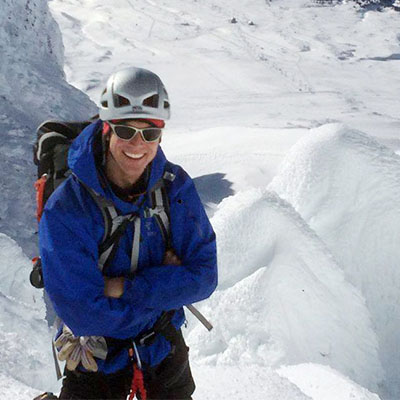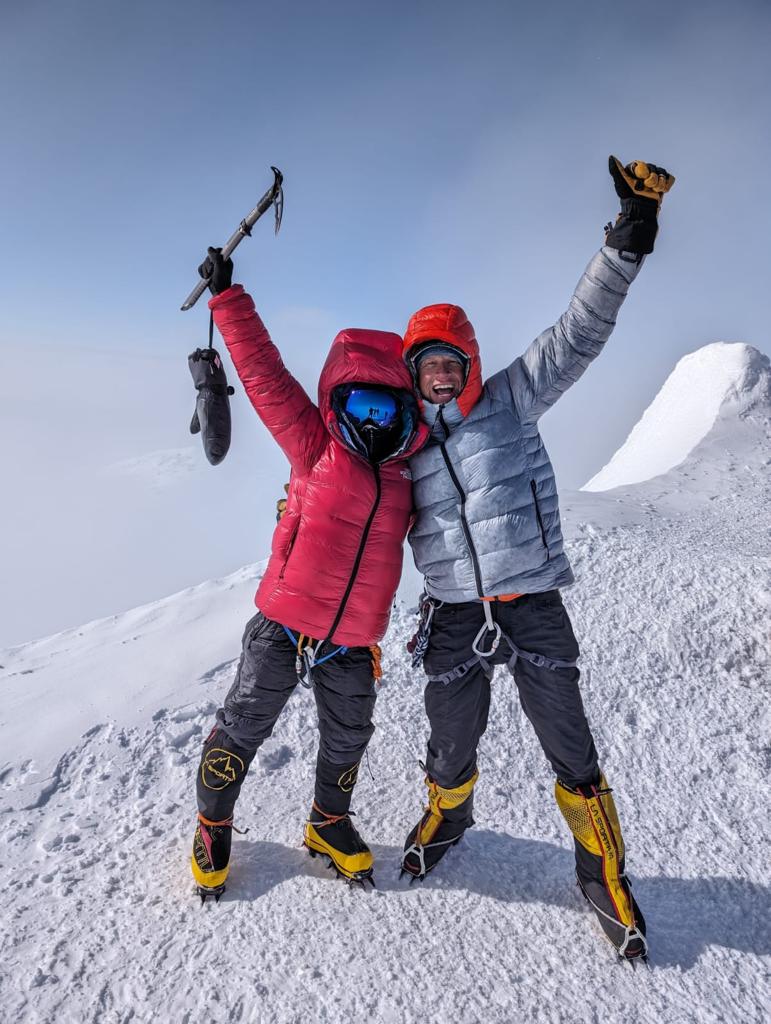Note from Garrett Madison, Lead Guide: I first attempted Ama Dablam in 2003 with a few of my mountain guide friends after a Cho Oyu expedition, my first season in the Himalayas. We did not reach the summit due to complications on the route. I returned in 2012, as a seasoned Himalayan guide and Expedition Leader with 3 climbers, and had an excellent climb, reaching the summit with all climbers on November 7th. It was one of the most enjoyable climbs of my career. I returned to Ama Dablam in the autumn of 2014 with a few climbers and again had a fantastic climb, and we have returned 6 times since having success on each expedition!!
Ama Dablam, or “mother’s necklace” is an iconic peak located in the Khumbu Valley of Nepal, and was first climbed in 1961. At 6812m / 22,349ft, ‘Ama’ is a challenging climb because of the steep faces of snow, ice, and rock that one must negotiate during the ascent of the Southwest Ridge. Climbers must have experience with fixed ropes, and be comfortable climbing along very exposed ridgelines. The view from the summit is spectacular, as one can see Everest, Lhotse, Makalu, Cho Oyu, and Sishapangma.
We begin our expedition by trekking from Lukla along the Dudh Kosi river through the Sherpa villages of Monjo, Namche, Debuche, then Pangbochce. From here we leave the valley and climb up to our base camp.
We have the finest base camp on the mountain. Because our camp is built on a large grassy plain, we are able to bring a large dining and communications tent, as well as personal tents that you can stand up in with a very plush mattress for sleeping. Fresh food is brought up daily from the valley so our base camp meals are truly delicious! We have a state of the art communications system that allows us to receive regular weather forecasts, make phone calls, and check-in via the internet, as well as coordinating with our climbers and Sherpas on the mountain. The views from base camp are stunning, and often we take breakfast outside in the sunshine to start the day.
Our high camps are reserved by our Sherpa team in advance of the season, as space in these camps is very limited. By reserving these camps and stocking them with provisions such as food and cooking equipment, we are fortunate in that we only have to carry our personal items with us during our acclimatization rotations and our ascent. Our Sherpa team will arrive in base camp several weeks ahead of us and begin setting the route. This is a huge advantage for us as setting the route on Ama can take weeks. By the time we arrive the route should be ready for climbing.
- Itinerary
- Dates and Costs
- Gear List
- Why Madison Mountaineering?
Day 1: Arrive Kathmandu. Check all gear, review program itinerary
Day 2: Fly to Lukla and trek to Monjo
Day 3: Trek to Namche
Day 4: Rest in Namche, acclimatization hike to Everest View Hotel for tea
Day 5: Trek to Debuche
Day 6: Trek to Pangboche, visit the High Lama for blessing
Day 7: Trek to Ama Dablam base camp (15,000′)
Day 8: Climb to Yak Camp (17,000), return to base camp
Day 9: Rest in base camp, review fixed line climbing techniques
Day 10: Move to Camp 1 (18,500′)
Day 11: Climb to Camp 2 (19,600′), sleep in Camp 1
Day 12: Descend to base camp
Day 13: Rest in base camp
Day 14: Move to Camp 1
Day 15: Move to Camp 2
Day 16: Move to Camp 2.7 (20,550′)
Day 17: Summit day and return to Camp 1 or base camp.
Day 18: Rest in base camp
Day 19: Trek to Namche
Day 20: Trek Namche to Lukla
Day 21: Fly Lukla to Kathmandu
Day 22: Depart Kathmandu for home
Days 23-27: Contingency days for bad weather, etc.
Ama Dablam Expedition
- October 20 – November 10, 2024
Deposit: USD 5,000
Ama Dablam and Cholatse: $28,250
adds 8 days to the itinerary
Costs Include:
- Airport pick up
- Welcome dinner in Kathmandu
- American mountain mountain guide, support staff, porters, cooks, climbing Sherpas
- Accommodations in Kathmandu (1 night) before the expedition, and (1 night) after the expedition.
- High quality lodges will be provided during the trek, and tents will be provided during the climb.
- We provide all meals during the trek and climb. We bring high quality food from the US and source local organic food from Nepal for this expedition (think real maple syrup and bacon!). We are happy to accommodate your dietary needs!
- All ground transportation in Kathmandu.
- All regular scheduled air transportation in Nepal. This includes round-trip air flights from Kathmandu to Lukla.
- All group gear such as tents, stoves and pots/pans, fuel, ropes, snow, ice & rock protection, VHF radios (we have a base station in our base camp and climbers carry hand held VHF radios), oxygen and other medical items if necessary.
- Climbing permits, garbage deposit and removal fee, liaison officer.
- Use of our satellite phone, and satellite modem for internet access.
Costs Do Not Include:
- Wire Transfer Fee
- Airfare to Nepal
- Food or Dining in Kathmandu and hotel expenses before the program begins, and after the climber has departed from the Khumbu Valley.
- Alcoholic beverages
- Bottled or canned beverages
- Specialty coffee or espresso drinks
- Personal items (see equipment list)
- Medical and Evacuation insurance
- Trip cancellation insurance
- Medical Release signed by your doctor.
- Any costs that are beyond the control of Madison Mountaineering.
Cancellation/Refund Policy
- There are no refunds for the deposit or balance payments for this expedition. This includes but is not limited to, expeditions that conclude without reaching or making progress towards expedition objective(s) (for example, the summit) due to route conditions, weather, insufficient manpower, or any other factor outside the control of Madison Mountaineering.
- Expedition leader has the final say on the expedition conclusion and will make all best efforts towards reaching expedition objective(s) within our margin of safety.
- Participants that choose to leave an active expedition for any reason are not entitled to any refunds
- Madison Mountaineering, LLC highly recommends trip cancellation insurance for all expeditions
- Due to the nature and heavy costs of government and operator permits, Madison Mountaineering must adhere to a stringent refund policy
- Deposit due with registration materials
- All balances are due 120 days prior to departure date unless otherwise specified
- Participants whose balances are not received by the 120-day deadline as stated above, risk forfeiture of their funds and their place on the expedition
Note: Madison Mountaineering, LLC reserves the right to waive any fees. As we offer personalized service, we will attempt to accommodate changes and cancellations when necessary, waiving certain fees when feasible. Deposits paid by participants acknowledge the above cancellation terms.
Base Layers
- Synthetic Short Underwear (2-3 pair): non-cotton style underwear
- Lightweight Long Underwear (2-3 pair): long sleeve shirt and long pants
- Heavyweight Long Underwear (1 pair)
- Short Sleeve Synthetic Shirt (1-2)
Mid Layers
- Soft Shell Jacket: to be worn over other layers
- Soft Shell Pants: very breathable and water repellant
- Lightweight Nylon Pants (1-2 pair)
Windproof/Rain Layers
- Hard Shell Jacket with hood: waterproof and breathable shell jacket
- Hard Shell Pants: waterproof and breathable shell pants
Insulation Layers
- Heavyweight Insulated Down Jacket with hood
- Insulated Pants
- Down Suit (optional): worn on summit day
Headwear
- Warm Hat: synthetic or wool hat (ski hat)
- Balaclava: to protect your neck and face in high winds
- Baseball Cap or other sun hat: to shade your face/neck from the sun on a hot day
- Bandana or Buff: to protect your neck/face from the sun
Eyewear
- Glacier Glasses: full protection with side covers or wrap around
- Ski Goggles: to be worn in the event of high winds
Gloves
- Lightweight Synthetic Liner Gloves: for wearing on warm days
- Soft Shell Gloves: to wear for moderate cold/wind
- Shell Glove with Insulated Liner: to wear for severe cold/strong wind
- Expedition Mitts: large enough to fit a liner glove inside
Footwear
- Liner Socks (3 pairs)
- Wool or Synthetic Socks (3 pairs)
- Mountaineering Boots
- Hiking Shoes/Boots: comfortable hiking boots or shoes for the trek to base camp
- Camp Boots (optional): comfortable boots for wearing in camp
- Gaiters (optional)
- Booties (optional)
Sleeping Equipment
- Sleeping Bag: rated to at least -20°F
- Self-inflating Sleeping Pad: full length is preferred
- Closed-cell Foam Pad: to be used in conjunction with the inflating pad for warmth and comfort when sleeping
- Earplugs
Mountaineering Gear
- Expedition Backpack: approximately 75L
- Compression Stuff Sacks: for reducing the volume of the sleeping bag, down parka, etc. in your pack
- Trash Compactor Bags: to line backpack and stuff sacks as well as for separating gear
- Backpack Rain Cover (optional)
- Trekking Backpack: to carry on the trek to base camp. Simple and light.
- Trekking Poles with Optional Snow Baskets: adjustable
- Ice Axe: short ice axe (max 60cm)
- Crampons: general mountaineering crampons
- Climbing Helmet: must be able to fit over your warm hat
- Ascender: 1 right or left-hand ascender
- “Y” Rig for ascender and safety carabiner
- Accessory Cord: 30 feet (9m) of 6mm accessory cord
- Alpine Climbing Harness: mountaineering harness, with adjustable leg loops. Not a rock-climbing “sport” harness
- Carabineers: 2 regular and 4 locking
- Belay/Rappel Device
- Headlamp: with 2 extra sets of new batteries
- Pack Liner (2 pieces)
Travel Items
- Large Duffel Bag with Lock: for transporting gear to base camp, no hard sides or wheels
- Small Duffel Bag with Lock: to store items in the hotel(s) while on the climb
- Carry-on Backpack: can use trekking backpack, approximately 18” x 16” x 10” (46cm x 41cm x 26cm)
- Travel Clothes: for days in cities and towns
- Lightweight journal, sketchbook, pencils, pen
- U.S. cash: for currency exchange to purchase SIM cards or merchandise in cities and villages
Additional Food Items
- Snack Food: bring a few days’ supply of your favorite climbing snack food such as bars, gels, nuts, beef jerky, etc. variety of salty and sweet is good
Other Equipment
- Cup: plastic 16 oz. minimum cup or mug
- Bowl: large plastic bowl for eating dinner or breakfast
- Spoon: plastic spoon (Lexan)
- Water Bottles (2 or 3): wide mouth bottles with 1-liter capacity
- Water Bottle Parkas (2): fully insulated with zip opening
- Water Treatment
- Thermos: 1-liter
- Hand/Foot Warmers
- Sunscreen: SPF 50 or better
- Lip Screen (2 sticks): SPF 30 or better
- Toiletry Bag: include toothbrush, toothpaste, toilet paper, baby wipes and hand sanitizer (2 small bottles)
- Pee Bottle: 1-liter minimum bottle for convenience at night in the tent
- Female Urination Device (FUD)
- Knife or Multi-tool (optional)
- Small Personal First-aid Kit: include athletic tape, band-aids, Ibuprofen, blister care, cough drops, etc.
- Medications and Prescriptions: bring antibiotics (Azithromycin, etc.), and altitude medicine such as Diamox, etc.
- Handkerchiefs/Bandanas (optional)
Optional Electronics
- Country-appropriate power plug adapters and power transformers
- Avalanche Transceiver
- Adventure Sports Watch: such as Garmin fēnix 6
- GPS/Personal Satellite Communicator: such as Garmin inReach Mini
- Personal Power System: such as Goal Zero Nomad 28 Plus Solar Panel and Sherpa 100AC Power Bank
- Digital Entertainment: movies, tv shows, music, books loaded on to smartphone, iPad, Kindle
- Camera: bring extra batteries, charger, and memory cards
- Portable Travel Humidifier: battery powered
Madison Mountaineering is recognized for well thought out strategy in leading high altitude climbing expeditions, as well as high-quality service throughout. We have two decades of experience in the planning and coordination of mountaineering expeditions, our reputation is excellent. We strive to make each expedition the best possible experience for our climbers and focus on our 3 primary goals of success in reaching the summit, returning safely, and having fun! Safety is always our number one priority.
Our guides are some of the best and most experienced in the industry, having a strong grasp of technical climbing, expedition, and high altitude experience, along with strong interpersonal skills. Our teams are small and equipped with the best support available to ensure the highest chance of success. We are renowned for our comfortable base camps, high-quality food, first-rate communications, and medical support services, all of which are overseen by a professional member of our team.
Most of our climbers have either climbed with us before, been referred by a friend who has climbed with us, or met one of our teams while attempting another peak and decided to join us for their next expedition. We work hard to facilitate safe, successful, and enjoyable expeditions for all of our climbers. Our track record and past climber testimonials prove we are highly competent experts in our field and love what we do!



























